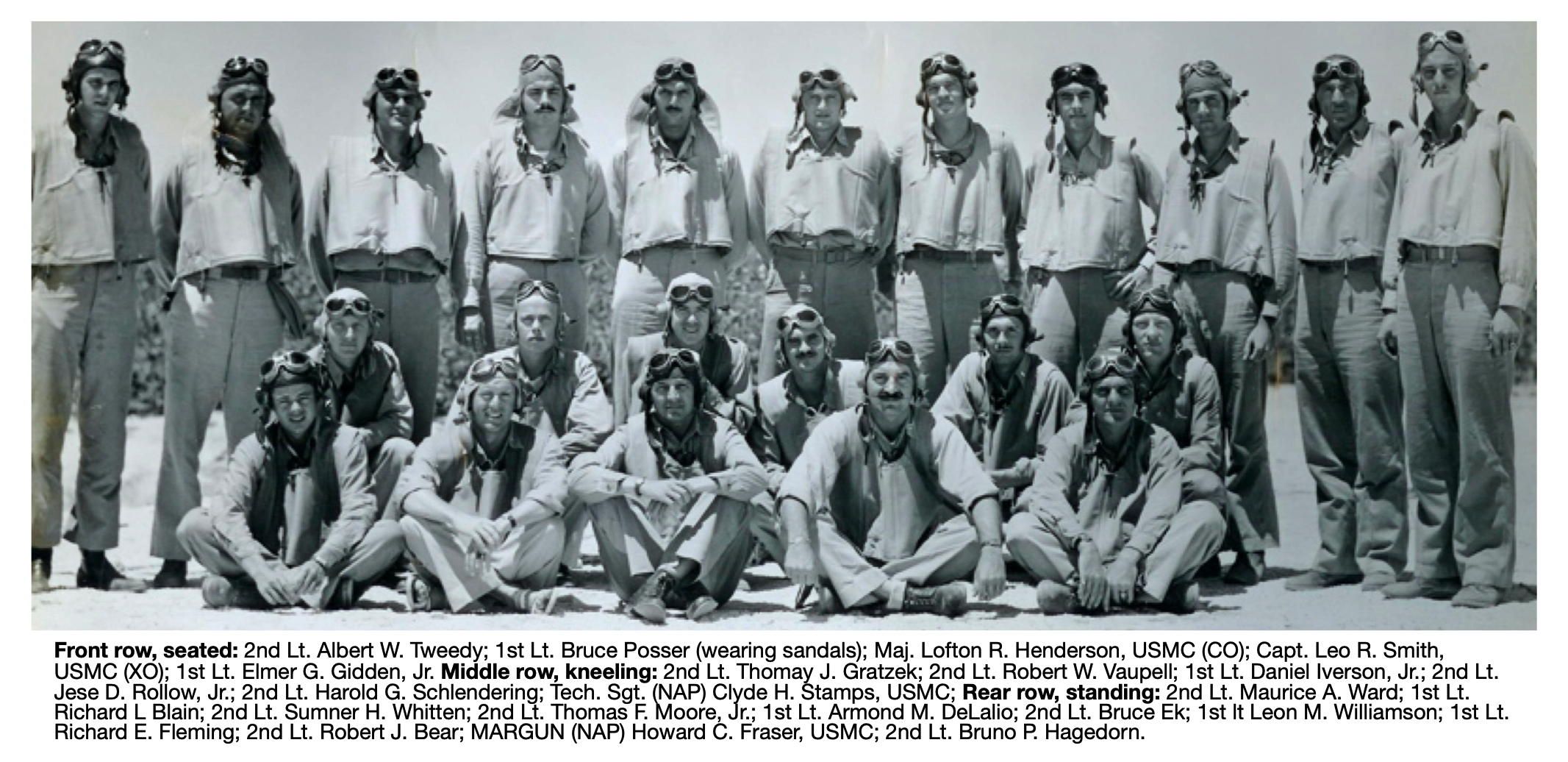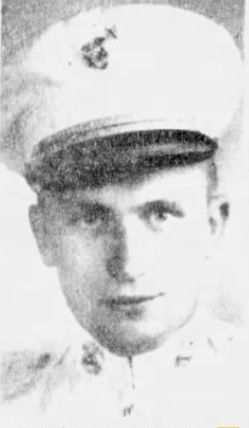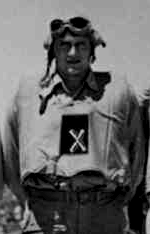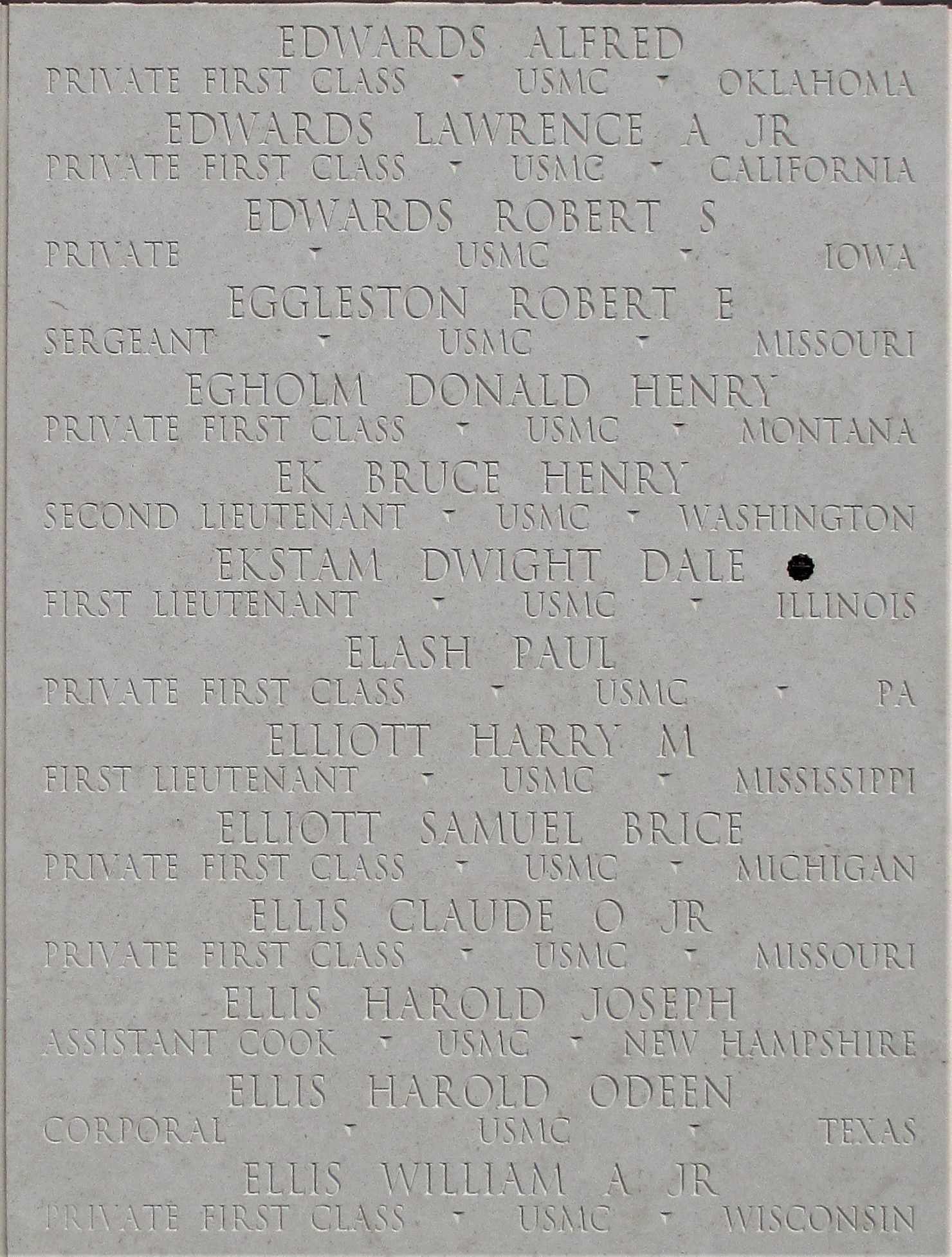The 1920 and 1930 U.S. Census reports the family as living in Spokane, Spokane County, Washington. The following family members are reported as living in the home at that time:
Head Fritz Oscar Ek M 47 Sweden
Wife Nelly Ek F 43 Sweden
Son Fritz R Ek M 20 Washington
Son David J Ek M 19 Washington
Son Lloyd W Ek M 16 Washington
Son Bruce H Ek M 11 Washington
The 1940 U.S. Census shows the same except brothers Fritz and David are now married and their wives are also living in the family home.
Bruce enlisted in the United States Marine Corps in 1940. After completing his boot camp training, he underwent a battery of tests and training to become a Marine pilot. He was accepted into the program and after months of flight school, he was awarded a second lieutenant's commission and his wings as a Marine dive bomber pilot.
Bruce was assigned to Headquarters Squadron of Marine Air Group (MAG)21 – formerly the Second Marine Aircraft Wing, based at Ewa Field, Hawaii. On March 24, 1942, Bruce and a handful of other new lieutenants, including John Butler, Ellwood Lindsay, and Albert Tweedy – boarded the USS Curtiss and sailed for Midway, joining VMSB-241, MAG-22.
Bruce flew a Vought SB2U Vindicator with VMSB-241 out of Midway; his gunner was PFC Raymond Brown. On May 26, the squadron received a few Douglas Dauntless SBD-2 dive bombers and the commanding officer, Major Lofton Henderson, divided his pilots into two groups. Bruce and PFC Brown were in the group that received the new aircraft, and flew in the second division of Henderson's group on the wing of Lieutenant Richard Blain.
Bruce had only a few days to learn the controls of his new Dauntless, #2184. On the morning of June 4, 1942, he and PFC Brown took off from Midway and, as Japanese planes turned the base to rubble behind them, flew off to try and find the carrier strike force that was approaching their territory.
After nearly ninety minutes in the air, the Americans spotted the carriers – and were in turn spotted by patrolling planes from the Japanese carrier HIRYU. The slow dive bombers, unable to dive properly due to the pilots inexperience, were easy targets. Soon, seven of the bombers were falling in flames – one of them carried Bruce and PFC Brown to their deaths.
For his courage that day, Bruce was awarded a posthumous Navy Cross. His citation reads as follows:
"The President of the United States takes pride in presenting the Navy Cross (Posthumously) to Bruce H. Ek (0-7534), Second Lieutenant, U.S. Marine Corps (Reserve), for extraordinary heroism and distinguished service in the line of his profession while serving as a Pilot in Marine Scout-Bombing Squadron TWO HUNDRED FORTY-ONE (VMSB-241), Marine Air Group TWENTY-TWO (MAG-22), Naval Air Station, Midway, during operations of the U.S. Naval and Marine Forces against the invading Japanese Fleet during the Battle of Midway on 4 June 1942. During the initial attack upon an enemy aircraft carrier, Second Lieutenant Ek, in the face of withering fire from Japanese fighter guns and anti-aircraft batteries, dived his plane to a perilously low altitude before releasing his bomb. Since he failed to return to his base and is missing in action, there can be no doubt, under conditions attendant to the Battle of Midway, that he gave up his life in the defense of his country. His cool courage and conscientious devotion to duty were in keeping with the highest traditions of the United States Naval Service."
To this day, Bruce's and PFC Raymond Brown's remains are lost in the Pacific Ocean, where they quite possibly are still with their plane.
At the time of his death, Brice's mother, Mrs. F. O. Ek, was living at East 2627-3rd Street, Spokane, Washington.
Second Lieutenant Bruce Henry Ek, Sn# 0-7534, earned the following badges/decorations for his service in the United States Marine Corps during World War II:
- Navy Gold Pilot's Wings
- Navy Cross Medal
- Purple Heart Medal
- Combat Action Ribbon
- Presidential Unit Citation Ribbon
- American Defense Service Medal
- Asiatic-Pacific Theater of Operations Campaign Medal with one bronze battle/campaign star
- World War II Victory Medal
**NOTE** - A portion of this bio is based on information from the website missingmarines.com. They have done a fantastic job of researching approximately 3000 US Marines whose bodies were lost in the war. This writer wholeheartedly recommends their site for researchers or families of the missing. - Rick Lawrence, MSgt., USMC/USAFR {RET})
The 1920 and 1930 U.S. Census reports the family as living in Spokane, Spokane County, Washington. The following family members are reported as living in the home at that time:
Head Fritz Oscar Ek M 47 Sweden
Wife Nelly Ek F 43 Sweden
Son Fritz R Ek M 20 Washington
Son David J Ek M 19 Washington
Son Lloyd W Ek M 16 Washington
Son Bruce H Ek M 11 Washington
The 1940 U.S. Census shows the same except brothers Fritz and David are now married and their wives are also living in the family home.
Bruce enlisted in the United States Marine Corps in 1940. After completing his boot camp training, he underwent a battery of tests and training to become a Marine pilot. He was accepted into the program and after months of flight school, he was awarded a second lieutenant's commission and his wings as a Marine dive bomber pilot.
Bruce was assigned to Headquarters Squadron of Marine Air Group (MAG)21 – formerly the Second Marine Aircraft Wing, based at Ewa Field, Hawaii. On March 24, 1942, Bruce and a handful of other new lieutenants, including John Butler, Ellwood Lindsay, and Albert Tweedy – boarded the USS Curtiss and sailed for Midway, joining VMSB-241, MAG-22.
Bruce flew a Vought SB2U Vindicator with VMSB-241 out of Midway; his gunner was PFC Raymond Brown. On May 26, the squadron received a few Douglas Dauntless SBD-2 dive bombers and the commanding officer, Major Lofton Henderson, divided his pilots into two groups. Bruce and PFC Brown were in the group that received the new aircraft, and flew in the second division of Henderson's group on the wing of Lieutenant Richard Blain.
Bruce had only a few days to learn the controls of his new Dauntless, #2184. On the morning of June 4, 1942, he and PFC Brown took off from Midway and, as Japanese planes turned the base to rubble behind them, flew off to try and find the carrier strike force that was approaching their territory.
After nearly ninety minutes in the air, the Americans spotted the carriers – and were in turn spotted by patrolling planes from the Japanese carrier HIRYU. The slow dive bombers, unable to dive properly due to the pilots inexperience, were easy targets. Soon, seven of the bombers were falling in flames – one of them carried Bruce and PFC Brown to their deaths.
For his courage that day, Bruce was awarded a posthumous Navy Cross. His citation reads as follows:
"The President of the United States takes pride in presenting the Navy Cross (Posthumously) to Bruce H. Ek (0-7534), Second Lieutenant, U.S. Marine Corps (Reserve), for extraordinary heroism and distinguished service in the line of his profession while serving as a Pilot in Marine Scout-Bombing Squadron TWO HUNDRED FORTY-ONE (VMSB-241), Marine Air Group TWENTY-TWO (MAG-22), Naval Air Station, Midway, during operations of the U.S. Naval and Marine Forces against the invading Japanese Fleet during the Battle of Midway on 4 June 1942. During the initial attack upon an enemy aircraft carrier, Second Lieutenant Ek, in the face of withering fire from Japanese fighter guns and anti-aircraft batteries, dived his plane to a perilously low altitude before releasing his bomb. Since he failed to return to his base and is missing in action, there can be no doubt, under conditions attendant to the Battle of Midway, that he gave up his life in the defense of his country. His cool courage and conscientious devotion to duty were in keeping with the highest traditions of the United States Naval Service."
To this day, Bruce's and PFC Raymond Brown's remains are lost in the Pacific Ocean, where they quite possibly are still with their plane.
At the time of his death, Brice's mother, Mrs. F. O. Ek, was living at East 2627-3rd Street, Spokane, Washington.
Second Lieutenant Bruce Henry Ek, Sn# 0-7534, earned the following badges/decorations for his service in the United States Marine Corps during World War II:
- Navy Gold Pilot's Wings
- Navy Cross Medal
- Purple Heart Medal
- Combat Action Ribbon
- Presidential Unit Citation Ribbon
- American Defense Service Medal
- Asiatic-Pacific Theater of Operations Campaign Medal with one bronze battle/campaign star
- World War II Victory Medal
**NOTE** - A portion of this bio is based on information from the website missingmarines.com. They have done a fantastic job of researching approximately 3000 US Marines whose bodies were lost in the war. This writer wholeheartedly recommends their site for researchers or families of the missing. - Rick Lawrence, MSgt., USMC/USAFR {RET})
Inscription
SECOND LIEUTENANT - USMC - WASHINGTON
Gravesite Details
Entered the service from Washington.
Family Members
Sponsored by Ancestry
Advertisement
Advertisement















